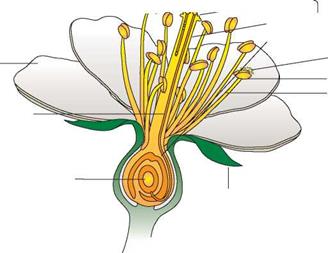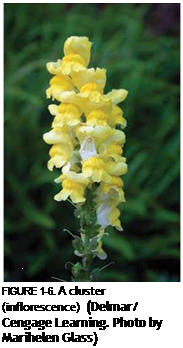Stems are the central axis of plants. They are usually above ground and may be long or short, single or multiple, and herbaceous or woody (these terms are defined later in the chapter). The principal functions of a stem are to conduct water and minerals absorbed by the roots to the leaves and other above-ground plant parts, and to conduct food materials produced in the leaves to the roots and other plant parts.
Stigma
![]()
![]()
![]()
![]()
 Style ^ Pistil Ovary
Style ^ Pistil Ovary
Pollen
![]() Anther Filament
Anther Filament
figure 1-4. Longitudinal section of a complete flower (Delmar/Cengage Learning)

 Leaves
Leaves
Leaves may be thin or flat, thick or fleshy, broad or needle-like. They are appendages of the stem and are the major food manufacturers of the plant. Leaves contain a green pigment, chlorophyll, which allows them to use the energy in light to convert carbon dioxide and water into food and oxygen. This process is called photosynthesis.
Cones or Flowers
Cones are the reproductive structures of the conifers such as pines, spruce, and firs. Cones contain naked, unenclosed seeds on the upper surface of each cone scale. The conifers are slightly more primitive in evolutionary development than the flowering plants.
Flowers epitomize the peak of evolutionary development in plants and make the flowering plants dominant in the plant kingdom. They are reproductive structures that produce seeds enclosed in fruit. Because the varying anatomical features of their flowers are one means of identifying plants, a knowledge of flower parts and types of flowers is necessary for horticulturists.
A complete flower is one that possesses all the floral organs (sepals, petals, stamens, and pistils) (Figure 1-4). An incomplete flower lacks one or more of these organs. In addition to being complete or incomplete, flowers may be perfect or imperfect. A perfect flower has both stamens (male reproductive organs) and pistils (female reproductive organs). An imperfect flower lacks one or the other. Imperfect flowers may be termed pistillate or staminate depending on which of the two essential organs they possess. If both pistillate and staminate flowers occur on the same plant, it is said to be monoecious. If the two imperfect flowers occur on separate plants, the plants are termed dioecious. Willows and hollies are examples of dioecious ornamental plants.
Flowers may be produced as single blossoms such as roses or lilies (Figure 1-5), in clusters (inflorescences) such as gladioli or snapdragons (Figure 1-6), or as composite flowers such as chrysanthemums (Figure 1-7). Composite flowers give the appearance of a single blossom but are actually a grouping of many tiny flowers.
![]()



